Under blanket of ice, lakes teem with life
There’s more going on under frozen lakes than researchers once believed
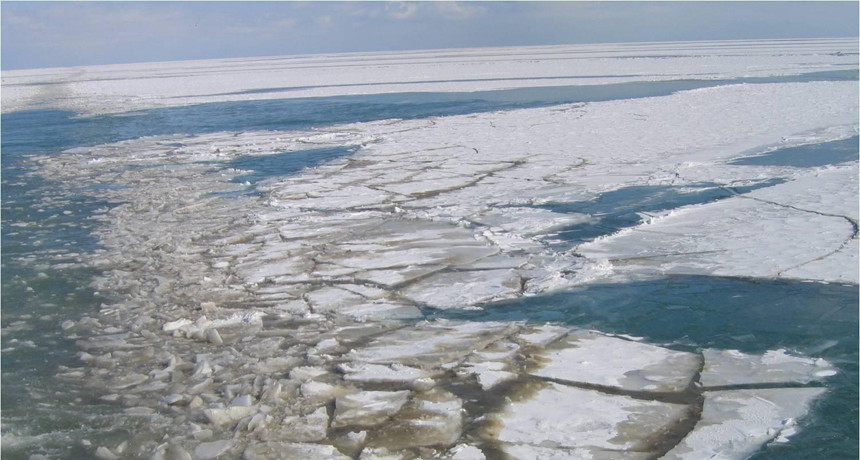
The brownish tinge that looks a lot like mud on the ice here, in Lake Erie, is something else. That "mud" is in fact billions of microscopic algae living on the underside of the ice. They're a crucial part of the lake's food web.
Michael Twiss
Frozen lakes are quiet places. Snow muffles sound. Boaters stay home. Animals do not visit for a drink. For a long time, scientists also thought nothing much was going on below the ice.
Turns out they were wrong.
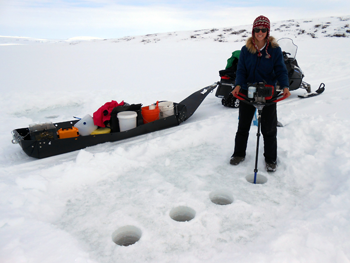
Many plants, animals and other forms of life hibernate or go dormant in winter. But new research shows that a surprising number remain active in cold months. In fact, some organisms only spring to life once a lake freezes over. Many others survive only by clinging to the ice’s underside.
To probe what goes on in these cold worlds, Stephanie Hampton gathered a team of more than 60 scientists from around the world who study freshwater (not salty) lakes. Hampton works at Washington State University in Pullman. As an aquatic ecologist there, she studies how water organisms relate to each other and to their surroundings.
Together, Hampton and her team analyzed more than 100 lakes during several recent winters. These bodies of water were scattered across the Northern Hemisphere and Antarctica. Their work represents the first in-depth survey of a large group of ice-covered freshwater lakes. And what they found surprised even them.
“None of us,” Hampton says, “expected life under the ice to be as abundant and diverse as it is.”
Scientists braved tough conditions
Gathering the new data wasn’t easy. The researchers braved the cold and risked plunging through frozen lakes to collect their data. Some scientists towed rowboats behind them as they trudged across lakes, so they could hop in if the ice started to crack. Others camped out in temporary huts that they built on very thick ice. Still others ventured out onto frozen lakes on snowmobiles or aboard icebreaker boats. (The good news: No one fell through the ice, notes Hampton.)
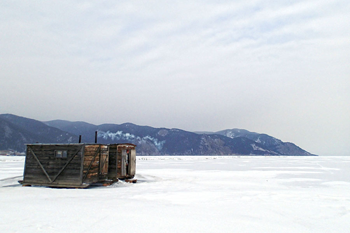
The researchers carried augers to drill holes through the ice, bottles for collecting the frigid water underneath and buckets for storing chunks of ice. They brought all of these lake samples back to their labs for study.
From there, they calculated how much algae and zooplankton had been growing beneath the winter ice. Algae are aquatic organisms. Zooplankton are tiny aquatic animals that eat algae. (Fish and other lake animals, in turn, eat zooplankton.)
In some lakes, researchers found winter concentrations of algae and zooplankton were higher than what had been present in summer. But those were rare cases. While each lake differed, the average amount of algae growing under the ice tended to be less than one-sixth of summer levels. And much of that algae had been clinging to the underside of the ice.
Winter zooplankton levels were, on average, about a third of summertime levels. Unlike algae, zooplankton float freely within the frigid ice-capped water.
The winter levels “may not sound like a lot,” Hampton says. Still, it was higher than expected and “shows lakes are still alive under the ice,” she says. This matters because many freshwater lakes are losing their ice cover. Climate change has been warming Earth’s air and water. Lakes no longer freeze as much as they did in the past. The ice also may not be as thick or last as long.
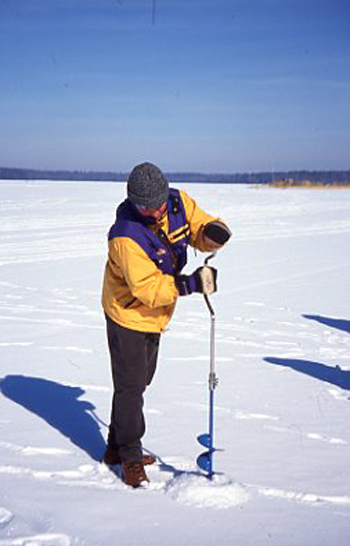
What happens if there is no ice for algae to cling onto? Does that mean less winter food for the zooplankton? And could that mean fewer zooplankton for fish to dine on during the winter?
Hampton’s team can’t say yet. So far, they know only what current conditions are. But that information gives them a baseline — a starting point — against which they can compare future conditions.
“No one is sure how having less ice will affect lakes. But having this baseline will help us be better prepared,” says Hampton.
Understanding how climate change affects lakes is important because people rely on these bodies of water for many things, such as drinking and irrigating crops. Fish that make these lakes their home also can be an important local source of food.
Hampton and her team described their new data in the Nov. 27, 2016 Ecology Letters,
Ocean research offers clues to what is at stake
That new work follows in the footsteps of marine researchers. These are scientists who study oceans. Marine scientists started to examine life under ocean ice a few decades ago. They were the first to discover that some algae live by clinging to the bottom of floating ice.
Unlike freshwater researchers, marine scientists also discovered that a lot of ocean algae live in water trapped between ice crystals. The salt water from the ocean freezes at a lower temperature than freshwater. Tiny salt water channels form in the ice. “These channels are perfect places for algae to hang out,” explains Warwick Vincent. He is an aquatic researcher at Laval University in Quebec City, Canada. He has studied both freshwater and marine ice.
“You don’t see these channels in freshwater,” he notes, “because there isn’t enough salt in the water.”
A few years after the discovery of sea-ice algae, research showed that these organisms are crucial to the ocean food web. Just as in freshwater lakes, sea-ice algae are an important food for zooplankton. Zooplankton in turn feed larger ocean creatures, such as fish and some whales.
Marine researchers learned that the critical time for sea algae to grow runs from late winter to early spring. Temperatures at this point begin to rise and ice starts to thin. That thinning ice lets in more light, which the algae use to produce food from carbon dioxide and water. Through this process, called photosynthesis, sunlight stimulates the growth of algae.
The timing is perfect, because this is also when zooplankton begin to reproduce. It means baby zooplankton have a banquet of algae on which to feed.
But because of global warming, spring — and its balmy temperatures — has begun arriving earlier in the year. This leads to an earlier melting of the sea ice. Marine researchers worry that algae may start growing too early — before zooplankton start to reproduce. Then when zooplankton are ready for their algal feast, many of those algae may have finished growing and fallen to the bottom of the ocean.
Marine scientists don’t know yet if this is happening: “I don’t think there is good enough data to test this at present,” says Vincent.
With early melting and less ice, zooplankton may face big troubles. That, in turn, might mean that zooplankton-loving predators — such as seabirds, fish and whales — will go hungry. For now, the scientists can’t predict how losing sea-ice algae might affect zooplankton and the larger creatures that feed on them.
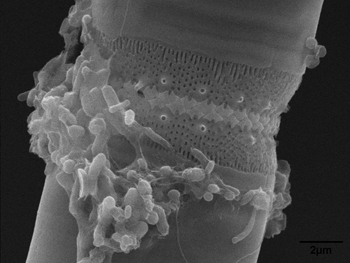
Something similar could be happening in lakes, the freshwater scientists worry. Hampton and her team hope their baseline data will help them find out. Still, they have good reason to suspect that what happens in the winter can affect lake life the rest of the year.
This is especially true for lakes that let a lot of sunlight in through ice. This happens when frozen lakes are not covered in snow (which blocks the light.) As in the ocean, sunlight stimulates the growth of algae — which are food for zooplankton.
Until the ice melts in the spring, cold-loving algae and zooplankton are an important food source for newly hatched fish. Later, when spring arrives, the young fish can turn to algae and zooplankton that grow in warmer water.
The concern, right now, is what may happen if there is less ice throughout the winter months.
‘Unusual’ Lake Erie
Hampton’s study is important for another reason: It is the first to compare winter and summer conditions for so many lakes, notes Stuart Jones. He works for University of Notre Dame in South Bend, Ind. There ,he studies aquatic ecosystems. The global lakes study was able to glean “a surprisingly large amount of data through cooperation and communication across many, many research groups in many areas of the world,” notes Jones.
One participant was Maggie Xenopoulos. She’s an aquatic ecologist in Canada at Trent University in Peterborough, Ontario. Xenopoulos analyzed water and ice samples from Lake Erie. One of the Great Lakes, it borders both Canada and the United States.
“Lake Erie is unusual because it has a lot of winter algae,” says Xenopoulos. Those algae cling to the underside of the ice, tinging it brown. This ice may look like mud and sand, she says, “but it’s teeming with life.”
In fact, Xenopoulos found that the amount of algae in Lake Erie during the winter can be similar to what’s there in summer. This happened mostly in areas where snow rarely blankets ice.
In one 2012 study, another team showed that concentrations of winter algae can be higher than those in summer. The most common algae was a species called Aulacoseira. It blooms only in the winter. (A bloom is a rapid growth of something — in this case, algae.)
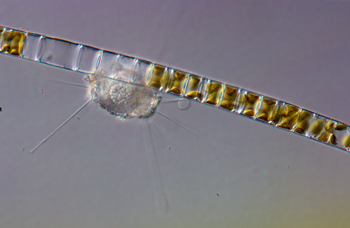
Previous research showed wintertime algae play an important role in Lake Erie. They consume nutrients, such as nitrogen and phosphorus. Lake Erie has unnaturally high levels of both. That’s mostly because of runoff from farmers’ fields. Farmers fertilize their fields to boost crop growth and yields. But crops do not absorb all of those nutrients. When it rains, the unabsorbed nitrogen and phosphorus wash into waterways that feed the lake.
If Lake Erie’s ice declines significantly, Xenopoulos worries, so too might winter algae. Then the algae won’t be around to consume their share of the lake’s excess nitrogen and phosphorus. This risks boosting summer levels of those nutrients.
This is a problem because a type of photosynthetic bacteria called cyanobacteria springs to life as the water warms. Like algae, these bacteria feed on nitrogen and phosphorous. When there is a lot of these nutrients in the water, the bacteria can bloom, creating huge patches of blue-green scum. Some cyanobacteria produce a toxin that can poison fish — and people.
Such blooms can have big consequences. Many towns and cities that surround Lake Erie get their drinking water from the lake. In August 2014, there was a very large, toxin-producing cyanobacteria bloom near Toledo, Ohio. To protect people, the city shut down for three days the supply of drinking water to more than 400,000 Toledo-area residents. Scientists worry that incidents like this could become more common if the winter algae decline.
“This is starting to look like a really bad story,” says Xenopoulos. “If the ice isn’t there, nutrients stick around to create even bigger summertime cyanobacteria blooms.”
Hampton says Xenopoulos and the other team members will continue their studies. In a few years, they hope to be able to predict better the impacts of declining lake ice.
“We are losing ice very quickly right now,” she says. “We really need to understand how climate change will affect lake food webs and water quality.”







